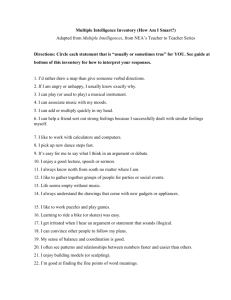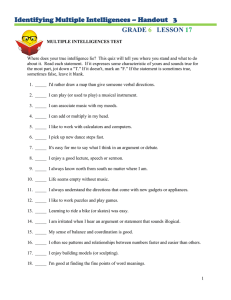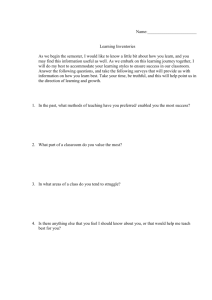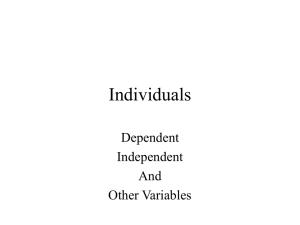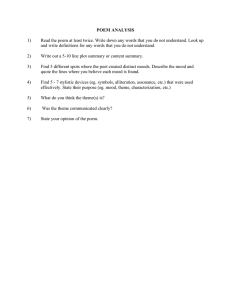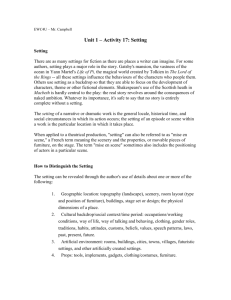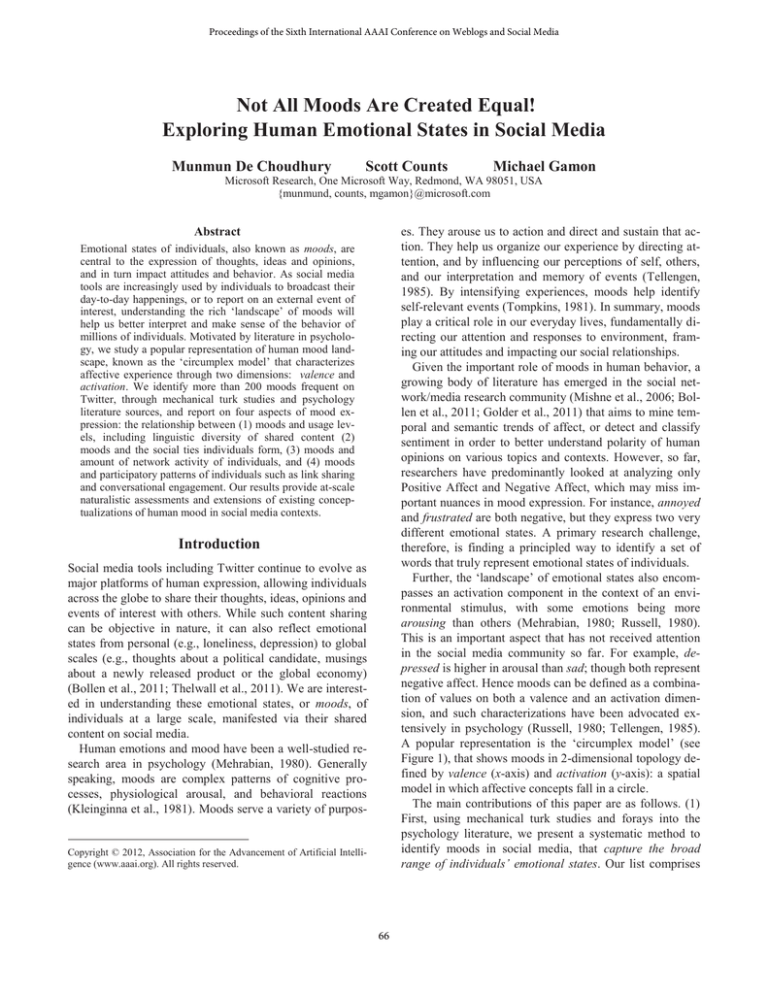
Proceedings of the Sixth International AAAI Conference on Weblogs and Social Media
Not All Moods Are Created Equal!
Exploring Human Emotional States in Social Media
Munmun De Choudhury
Scott Counts
Michael Gamon
Microsoft Research, One Microsoft Way, Redmond, WA 98051, USA
{munmund, counts, mgamon}@microsoft.com
es. They arouse us to action and direct and sustain that action. They help us organize our experience by directing attention, and by influencing our perceptions of self, others,
and our interpretation and memory of events (Tellengen,
1985). By intensifying experiences, moods help identify
self-relevant events (Tompkins, 1981). In summary, moods
play a critical role in our everyday lives, fundamentally directing our attention and responses to environment, framing our attitudes and impacting our social relationships.
Given the important role of moods in human behavior, a
growing body of literature has emerged in the social network/media research community (Mishne et al., 2006; Bollen et al., 2011; Golder et al., 2011) that aims to mine temporal and semantic trends of affect, or detect and classify
sentiment in order to better understand polarity of human
opinions on various topics and contexts. However, so far,
researchers have predominantly looked at analyzing only
Positive Affect and Negative Affect, which may miss important nuances in mood expression. For instance, annoyed
and frustrated are both negative, but they express two very
different emotional states. A primary research challenge,
therefore, is finding a principled way to identify a set of
words that truly represent emotional states of individuals.
Further, the ‘landscape’ of emotional states also encompasses an activation component in the context of an environmental stimulus, with some emotions being more
arousing than others (Mehrabian, 1980; Russell, 1980).
This is an important aspect that has not received attention
in the social media community so far. For example, depressed is higher in arousal than sad; though both represent
negative affect. Hence moods can be defined as a combination of values on both a valence and an activation dimension, and such characterizations have been advocated extensively in psychology (Russell, 1980; Tellengen, 1985).
A popular representation is the ‘circumplex model’ (see
Figure 1), that shows moods in 2-dimensional topology defined by valence (x-axis) and activation (y-axis): a spatial
model in which affective concepts fall in a circle.
The main contributions of this paper are as follows. (1)
First, using mechanical turk studies and forays into the
psychology literature, we present a systematic method to
identify moods in social media, that capture the broad
range of individuals’ emotional states. Our list comprises
Abstract
Emotional states of individuals, also known as moods, are
central to the expression of thoughts, ideas and opinions,
and in turn impact attitudes and behavior. As social media
tools are increasingly used by individuals to broadcast their
day-to-day happenings, or to report on an external event of
interest, understanding the rich ‘landscape’ of moods will
help us better interpret and make sense of the behavior of
millions of individuals. Motivated by literature in psychology, we study a popular representation of human mood landscape, known as the ‘circumplex model’ that characterizes
affective experience through two dimensions: valence and
activation. We identify more than 200 moods frequent on
Twitter, through mechanical turk studies and psychology
literature sources, and report on four aspects of mood expression: the relationship between (1) moods and usage levels, including linguistic diversity of shared content (2)
moods and the social ties individuals form, (3) moods and
amount of network activity of individuals, and (4) moods
and participatory patterns of individuals such as link sharing
and conversational engagement. Our results provide at-scale
naturalistic assessments and extensions of existing conceptualizations of human mood in social media contexts.
Introduction
Social media tools including Twitter continue to evolve as
major platforms of human expression, allowing individuals
across the globe to share their thoughts, ideas, opinions and
events of interest with others. While such content sharing
can be objective in nature, it can also reflect emotional
states from personal (e.g., loneliness, depression) to global
scales (e.g., thoughts about a political candidate, musings
about a newly released product or the global economy)
(Bollen et al., 2011; Thelwall et al., 2011). We are interested in understanding these emotional states, or moods, of
individuals at a large scale, manifested via their shared
content on social media.
Human emotions and mood have been a well-studied research area in psychology (Mehrabian, 1980). Generally
speaking, moods are complex patterns of cognitive processes, physiological arousal, and behavioral reactions
(Kleinginna et al., 1981). Moods serve a variety of purpos-
Copyright © 2012, Association for the Advancement of Artificial Intelligence (www.aaai.org). All rights reserved.
66
tures by measuring positive and negative affect in Twitter
posts, using the lexicon LIWC (http://www.liwc net/).
over 200 moods; and for each mood we include both the
valence and activation dimension. (2) Second, we analyze
these moods in the context of behavioral attributes that define an individual’s actions in social media, including
mood usage levels, linguistic diversity of shared content,
network structure, activity rates and participatory patterns
(link sharing / conversational engagement). (3) Finally,
through these studies, we provide naturalistic validation of
the mood landscape at a collective scale using the valence
and activation dimensions, and provide comparisons to
findings from the psychology literature, that extend existing conceptualizations of human moods.
Limitations. Despite widespread interest, it is clear that
the notions of affect and sentiment have been rather simplified in current state-of-the-art, often confined to their valence measure (positive/negative), with the six moods in
(Bollen et al., 2011) being an exception. However, as indicated, the psychology literature suggests that moods are
likely to have a ‘richer landscape’ beyond just their valence. That is, the activation component is equally important, and the inter-relatedness of valence and activation
in a systematic fashion is important in conceptualizing affect. Additionally, prior literature on social media has primarily focused on studying affect trends, or alternatively,
classifying sentiment. Little attention has been directed towards understanding how the expression of moods is associated with the behavior of individuals, e.g., their linguistic
usage of moods, social ties, activity levels, interaction patterns and so on. Through analyzing moods in social media
using notions of valence and activation in a circumplex
model, we propose that studying collective mood expression is a central contribution of this research.
Background Literature
Considerable research in psychology has defined and examined human emotion and mood (e.g., Ekman, 1973),
with basic moods encompassing positive experiences like
joy and acceptance, negative experiences like anger and
disgust, and others like anticipation that are less clearly
positive or negative. Of notable importance is the role of
intensity or activation in emotion and mood, defined as the
psychophysiological arousal of the mood in response to an
associated stimulus. Together with valence (i.e., the degree
of positivity/negativity of a mood), these two attributes
characterize the structure of affective experience (ref. PAD
emotional state model by Mehrabian, 1980; also the circumplex model of affect by Russell, 1980). In these works,
authors utilized self-reports of affective concepts to scale
and order emotion types on the pleasure-displeasure scale
(valence) and the degree-of-arousal scale (activation) based
on perceived similarity among the terms.
Turning to analyses of mood in social media, early work
focused on sentiment in weblogs. Mihalcea et al. (2006)
utilized happy/sad labeled blog posts on LiveJournal to determine temporal and semantic trends of happiness. Similarly, Mishne et al., (2006) utilized LiveJournal data to
build models that predict levels of various moods and understand their seasonal cycles according to the language
used by bloggers. More recently, Bollen et al. (2011) analyzed trends of public moods (using a psychometric instrument POMS to extract six mood states) in light of a variety of social, political and economic events. Nguyen
(2010) proposed models to infer emotional patterns in
blogs using normative emotional scores of English words.
Research involving affect exploration on Facebook and
Twitter has looked at trends of use of positive and negative
words (Kramer, 2010), sentiment extraction from posts
based on linguistic features (Barbosa et al., 2010; Kouloumpis et al., 2011), sentiment classification, as well as
sentiment flow in networks (Miller et al., 2011). Recently,
Golder et al., 2011 studied how individual mood varies
from hour-to-hour, day-to-day, and across seasons and cul-
Identifying Social Media Moods
We begin by discussing our methodology to identify representative mood words – signals that would indicate individuals’ broad emotional states. We then characterize the
moods by the two dimensions of valence and activation. In
the next part of this section, we present our method of inferring values of these dimensions for all mood words.
What are Representative Moods?
With the goal of developing a mood lexicon in a principled
manner that is relevant to social media, we started with the
following sources from prior literature in which explicit
mood expressions have been identified and investigated.
Sources. (1) Our primary source was a lexicon known as
ANEW (Affective Norms for English Words) that provides
a set of normative emotional ratings for ~2000 English
words (Bradley and Lang, 1999), including valence and activation measurements. (2) Our second source was LIWC
(Linguistic Inquiry & Word Count: http://www.liwc net/),
wherein we focused on sentiment-indicative categories like
positive / negative emotions, anxiety, anger and sadness.
(3) Third, we used a list of “basic emotions” provided by
(Ortony and Turker, 1990) that included approximately
100 words, including words like fear, contentment, disgust,
etc. (4) Our fourth source was the Emotion Annotation and
Representation Language (EARL) dataset that classifies 48
emotions in various technological contexts (http://emotionresearch net/projects/humaine/earl). (5) Finally, to complement these sources with mood words in online contexts,
67
we used the list of moods from the blogging website
LiveJournal (http://www.livejournal.com/). On LiveJournal, blog authors can tag their posts with appropriate mood
words.
Mechanical Turk Study for Mood Identification. A
number of words in this preliminary list pooled from the
five sources bore the notion of positive/negative feelings,
but were not appropriate as a mood. For example, “pretty”
and “peace” both represent positive affect, but are not convincingly moods. Hence we performed a filtering task to
identify mood-indicative words from this candidate list.
This filtering task progressed in two parallel phases. In
one phase, two researchers (fluent English speakers) were
asked to rate each of these words on a Likert scale of 1 – 7,
where 1 indicated “not a mood at all” and 7 indicated “absolutely a mood”. This gave us a set of high quality baseline ratings. In the other parallel phase, we set up a similar
mood-rating collection task using the framework provided
by Amazon’s Mechnical Turk (AMT) interface
(http://aws.amazon.com/mturk/). Like the researchers, the
turkers were asked to rate the words on the 1 – 7 Likert
scale. Each word was rated by 12 turkers, and we considered only those turkers who had a greater than 95% approval rating and were from the United States.
Using the ratings from the turkers and the researchers,
we constructed a list of all those words where both the median turk rating and the median researcher rating was at
least 4 (mid-point of the scale), and the standard deviation
was less than or equal to 1. This gave us a final set of 203
mood words that were agreed upon by both parties to be
mood-indicative (examples include: excited, nervous, quiet, grumpy, depressed, patient, thankful, bored).
Q2
Q1
Q3
Q4
Figure 1. Moods represented on the valence-activation
circumplex model. The space has four quadrants, e.g.,
moods in Q1 have higher valence and higher activation.
vation. Finally, we combined the ratings per mood for valence and activation separately, and used the corresponding
mean ratings as the final measures for the two attributes
(Fleiss-Kappa measure of inter-rater agreement was 0.65).
Circumplex model
The outcome of the two phases of AMT studies was a set
of 203 words, with each word characterized by both the valence and activation dimensions. Figure 1 illustrates the
circumplex model (yellow circle) that results when each
mood word (shown as a square) is plotted in 2-dimensions
defined by its mean valence (x-axis) and activation (y-axis)
ratings. Several features of this resulting space align with
similar circumplex models found in prior psychology literature (Russell, 1980). First, the number of different mood
words are fairly equally distributed in the four quadrants
Q1 – Q4 (starting from top right, moving counterclockwise). Second, while the valence ratings cover almost the
entire range between 1 and 10, there are fewer mood words
with very high activation or very low activation, compared
to valence. Also note that words of neutral valence (e.g.,
quiet) tend to be of lower activation. This is reasonable, as
typically more extreme moods (e.g., infuriated) generate
higher activation. Overall this circumplex model provides
us a fine-grained psychometric instrument for study of
mood expression in Twitter.
Inferring Mood Attributes Values
Given the final list of representative moods, our next task
was to determine the values of the valence and activation
dimensions of each mood. For those words in the final list
that were present in the ANEW lexicon, we used the
source-provided measures of valence and activation, as
these values in the ANEW corpus had already been computed after extensive and rigorous psychometric studies.
For the remaining words, we conducted another turk study,
to systematically collect these measurements.
Like before, we considered only those turkers who had at
least 95% approval rating history and were from U.S. For a
given mood word, each turker was asked to rate the valence and activation measures, on two different 1 – 10 Likert scales1 (1 indicated low valence/low activation, while
10 indicated high valence/high activation). We thus collected 24 ratings per mood – 12 each for valence and acti-
Collecting Labeled Mood Data
We focused on collecting data on moods from the popular
social media Twitter. Because of its widespread use, Twit-
1
The choice of this Likert scale was made to align with the scales of valence and activation in the ANEW lexicon.
68
we first gathered responses from a set of Twitter users via
a study on Amazon’s Mechanical Turk. The study intended
to determine for how many cases a hashtagged mood word
occurring at the end of a Twitter post truly captures an individual’s mood (without the presence of external signals).
Specifically, we displayed a Yes/No question alongside a
Twitter post, to which the turker indicated whether the
(highlighted) mood hashtag at the end of the post indeed
reflected the author’s sentiment. Like before, we again
considered U.S. turkers with greater than 95% approval
rating history, and then added the requirement of using
Twitter at least five times a week (consuming content).
Separately, we also compared the quality of our mood
data to a naïve method of spotting mood words anywhere
in a Twitter post. Like before, we used Amazon’s Mechanical Turk to determine for how many cases a mood word
present anywhere in a post indicated the author’s sentiment. For both the studies, this exercise was conducted
over 100 posts per study, and each post was rated by 10
different turkers.
The studies indicated that in 83% of the cases,
hashtagged moods at the end of posts indeed captured the
users' moods; while for posts with moods present anywhere, only 58% captured the emotional states of the corresponding users (Fleiss-Kappa measures of inter-rater
agreement for both studies were 0.68 and 0.64 respectively), thus providing a systematic verification of the quality
of our labeled mood dataset.
ter can be seen as a large and reliable repository for observing the rich ensemble of moods we consider in this paper. We utilized the Twitter Firehose that is made available
to us via our company's contract with Twitter. We focused
on a full year's worth of Twitter posts posted in English,
from Nov 1, 2010 to Oct 31, 2011. Since there is likely to
be a considerable volume of Twitter posts that does not reflect moods, and due to the scarcity of mood-labeled
ground truth, our major challenge was to eliminate as many
non-mood-indicative posts as possible, while simultaneously avoiding labor-intensive manual labeling of posts
with moods. We hoped to yield a high precision / low false
positive set of posts that truly captured moods on Twitter.
To tackle this challenge, we observed that Twitter users
share posts with hashtagged moods, often with the hashtag
at the end of the tweet, which might serve as labels for
constructing our mood dataset. Consider the following post
for instance: “#iphone4 is officially going to be on verizon!!! #excited”. In this light, we followed prior work
where the authors used Twitter’s hashtags and smileys as
labels to train sentiment classifiers (Davidov et al., 2010).
We collected posts which have one of the moods in our
mood lexicon in the form of a hashtag at the end of a post.
By this process, our labeled mood dataset comprised about
10.6 million tweets from about 4.1 million users.
Verifying Quality of Mood Data
Collection of such labeled data on moods can be relatively
easy since it avoids manual annotations or computationally
intensive machine learning, but how reliable is it to consider mood hashtags at the end of posts as true indicators of
an individual’s emotional state? To answer this question,
Q2
Q1
Q3
Q4
Usage Analytics of Moods
Our first study of mood exploration on Twitter data is
based on analyzing the circumplex model of moods in
terms of the moods’ usage frequencies. We illustrate these
mood usage frequencies (count over all posts) on the circumplex model in Figure 3, where the size of squares (i.e.,
moods) is proportional to its frequency. We note that the
usages of moods in each of the quadrants is considerably
different (the differences between each pair of quadrants
were found to be statistically significant based on independent sample t-tests: p<0.0001). The overall trend shows
that moods in Q3 (low valence, low activation) tend to be
used extensively (sad, bored, annoyed, lazy), along with a
small number of moods in Q1, of relatively higher valence
and activation (happy, optimistic). Overall, usage frequencies of lower valence moods exceed those of higher valence moods.
We hypothesize the presence of a “broadcasting bias”
behind these observations. Since individuals often use
Twitter to broadcast their opinions and feelings on various
topics, it is likely that the mood about some information
needs to be of sufficiently low or high valence to be worth
reporting to the audience. This appears to be particularly
true with respect to positive valence terms, with mildly
Figure 2. Circumplex model showing usage frequencies
of moods used as hashtags at the end of Twitter posts:
larger squares represent higher frequency of usage.
69
positive moods expressed only rarely. The observation that
lower valence moods are shared more often might be due
to individuals seeking social support from their audiences
in response to various happenings externally as well as in
their own lives. The observation that lower activation
words dominate usage of these lower valence moods could
reflect the simple fact that people experience these moods
more than their high activation counterparts (people are
bored more frequently than they are infuriated) or that it is
less acceptable to express extreme negative moods.
We also explore how the linguistic content associated
with usage of various moods relates to their valence and
activation. Like before, we show the moods (as squares) on
the circumplex model (Figure 2). The color of the squares
indicate a mood’s normalized entropy, defined as the entropy of the textual content (i.e., unigrams over all posts
associated with the mood), divided by the total number of
posts expressing the mood. In the figure, lighter shades indicate higher entropy. We observe that squares on the right
side of the circumplex model (Q1, Q4) tend to have higher
entropy than left (Q2, Q3) (statistically significant based
on an independent sample t-test). This indicates that while
positive moods tend to be shared across a wide array of
linguistic context (topics, events etc.), negative moods tend
to be shared in a limited context, confined to limited topics.
of followees (outlinks) of an individual. We assume that
individuals with a ratio close to 1 would be the most “social” since this implies roughly equal engagement on the
part of those individuals in both outgoing and incoming
social and information exchanges. When the ratio is significantly less than 1, it may indicate that the individual is not
interesting enough to others and thereby possibly less “social” to the Twitter audience. On the other hand a high ratio much greater than 1 indicates that the individual is likely an elite user (e.g., a celebrity or news source) who typically is more of a broadcaster and thus also is not very “social” in the context of Twitter. Nevertheless, we note that
this measure of sociality does not incorporate the absolute
number of followers and followees (i.e., two people with
sociality ratios of 20/20 and 2000/2000 respectively would
be considered equally ‘social’). We argue, however, that
sociality of an individual is likely to be a function of the
#followers and #followees together, since they define the
structure of his/her ego-network. Hence the ratio is more
appropriate than the absolute values. Certainly, other network-centric measures to study the relationship between
followers and followees could be used (notably, clustering
coefficient), and would be worth exploring in the future.
We again use the circumplex model to represent relationship between moods and sociality. In Figure 4, we
show the circumplex model where each square is a mood
and is represented by a color on an RGB scale, indicating
the mean #followers/#followees ratio of individuals who
shared the mood. A red square denotes a low #followers/#followees ratio of the individuals who shared the
mood, while blue denotes a high #followers/#followees ra-
Sociality and Moods
In our next study, we intend to investigate the relationship
between the nature of moods expressed and how “social”
an individual is, referred to as “sociality”.
For the purposes of this paper, we define sociality to be
the ratio of the number of followers (inlinks) to the number
Q2
Q3
Q2
Q1
Q3
Q4
Q1
Q4
Figure 3. Circumplex model showing entropies of
moods in terms of the content of posts: higher valence
moods (shown in lighter shades) have higher entropy.
Figure 4. Circumplex model of moods showing the relationship between mood expression and sociality (defined as #followers/#followees ratio).
70
tio: both indicating that the individuals who share these
moods are not very “social” according to our definition.
Moods whose squares are green are the most “social”, with
ratios of #followers/#followees close to 1. From Figure 4,
we observe2:
1. Moods of higher valence (Q1, Q4) tend to be green
squares, indicating that the average individual sharing
them has a #followers/#followees ratio close to 1, in other words is more “social”. On the other hand, moods of
lower valence (Q2, Q3) are consistently red, i.e., individuals sharing them are not very “social”.
2. Blue square users are comparatively infrequent and tend
to use moods from all quadrants. To the extent that these
users are elite users, this indicates that, most times, they
are reporting information on various events / topics in a
rather objective and ‘mood-balanced’ manner.
These results indicate a relationship between the egonetwork of individuals (i.e., the way they connect to others) and the expression of moods. While our results do
show that there is positive correlation between one being
more “social” and expressing moods of higher valence,
they do not establish a causal relationship in any direction.
Our results, however, appear to confirm findings in prior
studies that indicate that positive moods appear to be associated with social interactions (Vittengl and Holt, 1998).
Q2
Q1
Q3
Q4
Figure 5. Circumplex model of moods showing the relationship between mood expression and activity (twitter
posts made per second by an individual sharing the
mood). Larger squares indicate higher activity.
frequently by individuals with low activity. Interestingly,
when combined with the usage frequencies from Figure 3,
this implies that a “tail” of users post relatively infrequently and express the bulk of the mildly negative moods
(bored, lazy, annoyed, sad).
Activity Level and Moods
Next we investigate the relationship between an individual’s activity and his/her mood expression. We define a
measurement of how “active” s/he is in sharing posts: the
number of posts shared per second since the time of the individual’s account creation. We conjecture that a highly
active individual is likely to be more “social” as well, since
s/he is interested in dissipating information to his/her audience consistently, and thereby remain connected to them.
Based on this definition, we show the circumplex model
of moods in Figure 5. The size of each square in this case
is proportional to the mean rate of activity of all individuals who have shared the particular mood. The figure shows
that the majority of the larger squares (or moods shared by
highly “active” individuals) lie in Q1 and Q4; in other
words, high (or positive) valence moods are shared by
highly active individuals (statistically significant based on
independent sample t-tests between quadrant pairs). On the
other hand, moods of high activation (in Q2) but low valence are shared primarily by individuals with a low activity rate. In general, this indicates that positive moods are associated more frequently with active individuals, while
negative and high arousal moods appear to be shared more
Participatory Patterns and Moods
In our final study, we examine two types of participatory
patterns of individuals in relation to expression of mood:
sharing of (external) information via links, and conversational engagement of one individual with another via @reply in Twitter posts.
Our interest lies in investigating how mood expression
and participation interact in the context of external information sharing and conversational engagement, compared
to similar contexts where moods are not shared. To this
end, we compute the “background probabilities” of link
sharing (say, pli) and @-replies (prp), given as ratio of
#links (or @-replies) in posts to the total number of posts.
Thereafter, for each mood, we compute the probability of
the mood’s co-occurrence in a post along with, first a link,
and second an @-reply. We then compute a distribution of
the number of moods that have occurrence probabilities
less than or equal to the background probability and those
greater than the background probability (of links, @replies). Frequency histograms of the distributions are then
plotted against mood valence and activation (Figure 6):
1. Highly negative moods (low valence) tend to co-occur
less frequently with a link or an @-reply, compared to
2
To formalize these differences, we compared the #followers/#followees
ratios associated with all moods in Q1 through Q4 using independent
sample t-tests and the results were statistically significant: p<0.001.
71
the respective background probabilities (1st and 3rd lines
in (a)). On the other hand, several highly positive moods
(higher valence) co-occur more frequently than usual
with a link (2nd line in (a)). This is likely to indicate that
when individuals choose to express moods in a linkbearing post, it is more frequently a positive than a negative mood. In general, mood expression, positive or negative, is quite low in posts with @-replies (4th line in (a)).
2. Low activation moods tend to co-occur less frequently
with a link, compared to the respective background
probability (1st line in (b)), while high activation moods
appear to be relatively more frequently co-occurring
with links (2nd line in (b)). Finally, moods co-occurring
with @-replies are overall quite infrequent, irrespective
of their activation measures. In fact, a large number of
moods co-occur with @-replies with a probability much
lower than the respective background probability.
Based on these findings, it appears that there is a difference in the manner in which moods are shared in various
participation contexts. For link sharing, when links and
moods co-occur, those moods tend to be both positive and
of moderate to high activation. Replies, on the other hand,
show little in the way of mood expression.
Discussion
In this paper we extended literature on mood/affect analysis in social media by studying more than 200 fine-grained
human moods at a large scale, and in light of not only their
valence but also their activation. We utilized the notion of
the circumplex model popular in the psychology literature
(Russell, 1980) and studied various aspects of the relationship between mood expression and human behavior in social media: mood usage, social ties, activity level, and participatory patterns (link sharing, conversational engagement). To the best of our knowledge, naturalistic validation of the circumplex model and quantifying mood usage
at scale was done for the first time in this paper.
Our findings indicated both similarities and differences
with prior literature. Although the circumplex model had
rather equal distribution of moods in each quadrant in
terms of the valence and activation dimensions (drawn
from and consistent with the literature), mood usage frequencies as well as diversity of linguistic content in mood
sharing varied considerably across the circumplex model
(unknown in prior literature). While negative and low activation moods were more frequent, a few positive and high
activation moods showed high use. At the same time, the
linguistic use of positive moods seemed to span a variety
of contexts / topics (high entropy), while that of negative
moods seemed concentrated in a limited context. The addition of usage frequencies and linguistic use to valence and
activation in this manner thus helped to validate the topology of the circumplex model in the social media context
and showed that all moods are after all not created equal!
Further, we observed a relationship between the social
ties formed by individuals and the moods expressed: positive moods were correlated with highly ‘social’ people.
This confirmed findings in the literature that show that in
our social interactions, moods help regulate social relationships (Averill, 1976), and can stimulate pro-social behavior
(Vittengl and Holt, 1998). Similarly, the finding that highly
active individuals tend to share more positive moods is
supported by evidence in prior literature indicating that
daily activities and social events tend to be correlated with
positive affect (Clark et al., 1988).
Findings from the participatory patterns and mood expression analysis further revealed insights that augment
prior literature. Frequent co-occurrence of positive moods
and link sharing indicated that the external information
sharing behavior typically bears positivity. This might be
related to the well-studied observation that positive moods
are contagious and propagate in a network (Lykken, 2000).
Finally, although positive moods have historically been
found to be associated with different types of conversations
(a)
(b)
Figure 6. Mood distribution over valence and activation, for two types of participatory behavior: external
information sharing, and conversational engagement.
72
Bradley, M.M., & Lang, P.J. (1999). Affective norms for English
words (ANEW). Gainesville, FL. The NIMH Center for the Study
of Emotion and Attention.
Buck, R. (1984). The communication of emotion. New York:
Guilford.
Clark, Lee A. & Watson, David (1988). Mood and the mundane:
Relations between daily life events and self-reported mood. Journal of Personality and Social Psychology, Vol 54(2), 296-308.
Davidov, D., Tsur, O., & Rappoport, A. (2010). Enhanced Sentiment Learning Using Twitter Hashtags and Smileys. Proceedings
of the 23rd International Conference on Computational Linguistics Posters, (August), 241-249.
Ekman, P. (1973). Cross-cultural studies of facial expressions. In
P. Ekman (Ed.), Darwin and facial expression: A century of research in review (pp. 169-229).
Golder, S. A., & Macy, M. W. (2011). Diurnal and Seasonal
Mood Vary with Work, Sleep and Daylength Across Diverse Cultures. Science. 30 Sep 2011.
Kleinginna, P.R., & Kleinginna, A.M. (1981). A catagorized list
of motivation definitions with a suggestion for consensual definition. Motivation and Emotion, 263-291.
Kouloumpis, E., Wilson, T., & Moore, J. (2011). Twitter Sentiment Analysis: The Good the Bad and the OMG! In Proc. ICWSM 2011.
Kramer, A. D. I. (2010). An unobtrusive behavioral model of
“gross national happiness”. In Proc. CHI 2010. 287-290.
Lykken, D. (2000). Happiness: The nature and nurture of joy and
contentment. New York: St. Martin's Press Griffin.
Mehl MR, Vazire S, Holleran SE, Clark CS. (2010). Eavesdropping on happiness: well-being is related to having less small talk
and more substantive conversations. Psychol Sci. 2010
Apr;21(4):539-41.
Mehrabian, Albert (1980). Basic dimensions for a general psychological theory. pp. 39–53.
Mihalcea, R., & Liu, H. (2006). A corpus-based approach to finding happiness. In Proceedings of computational approaches for
analysis of weblogs, AAAI Spring Symposium.
Miller, M., Sathi, C., Wiesenthal, D., Leskovec, J., & Potts, C.
(2011). Sentiment Flow Through Hyperlink Networks. In Proc.
ICWSM 2011.
Mishne, G. & de Rijke, M. (2006). Capturing Global Mood Levels using Blog Posts. In AAAI 2006 Spring Symposium on Computational Approaches to Analyzing Weblogs.
Nguyen, T. (2010). Mood patterns and affective lexicon access in
weblogs. In Proceedings of the ACL 2010 Student Research
Workshop (ACLstudent '10). 43-48.
Ortony, A., & Turner, T. J. (1990). What's basic about basic emotions? Psychological Review, 97, 315-331.
Russell, James A. (1980). A circumplex model of affect. Journal
of Personality and Social Psychology: 39, pp. 1161–1178.
Tellegen, A. (1985). Structures of mood and personality and their
relevance to assessing anxiety, with an emphasis on self-report. In
A. H. Tuma & J. D. Maser (Eds.), Anxiety and the anxiety disorders (pp. 681-706).
Thelwall, M., Buckley, K., & Paltoglou, G. (2011). Sentiment in
Twitter events. In J. Am. Soc. Inf. Sci. Technology.
Tompkins, R.D. (1981). Before it’s too late…: The prevention
manual on drug abuse for people who care. Englewood Cliffs,
NJ: Family Information Center.
Vittengl, J. R., & Holt, C. S. (1998). A time-series diary study of
mood and social interaction. Motivation and Emotion, 22(3), 255275. Springer.
and communication processes (Buck, 1984; Mehl et al.,
2010), our observations indicated otherwise: moods,
whether positive or negative, do not co-occur frequently in
an @-reply post. The reason for this departure from previous research could be due to a number of aspects of Twitter, e.g., usage norms wherein people are likely to communicate little about their moods through an explicit
hashtag when engaged in conversation directed toward
someone, compared to a context when they are reaching
out to a broad audience on some issue of interest.
Our work provides ample opportunity for future research. A limitation of current work is that we have analyzed mood characteristics across all Twitter users, without
making distinctions between user types. For instance, the
mechanisms of mood expression might be different for celebrities compared to ordinary individuals. Finally, while
we have comprehensively considered a variety of mood
words that typically occur on Twitter, the lexicon could be
augmented in the future with moods that have ‘evolved’ on
these novel communication modalities and have not been
investigated traditionally (e.g., ‘#yay’ would indicate a
positive, moderate activation mood, frequent on Twitter).
From an applications perspective, this research provides
promising avenues to build mood classifiers useful in
search and advertising, or to enable organizations track behavior of populations in health, socio-economics or urban
development domains.
Conclusions
Moods impact human behavior, responses to environmental stimuli, and social ties. Naturally, it is imperative to understand characteristics of moods on social media in order
to decipher the collective behavior of large populations. In
this paper, we identified and studied a variety of moods
that frequent Twitter posts. We used the dimensions of valence and activation to represent moods in the circumplex
model and studied the topology of this space with respect
to mood usage, network structure, activity, and participatory patterns. This work provides naturalistic validation of
the circumplex model using Twitter data, extends this conceptualization of human mood to incorporate usage levels
and linguistic diversity, and provides evidence connecting
mood usage to social structure and interaction behaviors.
References
Averill, J.R. (1976). Emotion and anxiety: Sociocultural, biological, and psychological determinants. In M. Zuckerman & C.O.
Spielberger (Eds.). Emotion and anxiety: New concepts, methods,
and applications (pp. 87-130).
Barbosa, L. & Feng, J.. (2010). Robust sentiment detection on
Twitter from biased and noisy data. Proc. COLING 2010. 36-44.
Bollen, J., Mao, H., & Pepe, A. (2011). Modeling Public Mood
and Emotion: Twitter Sentiment and Socio-Economic Phenomena. In Proc. ICWSM 2011.
73

